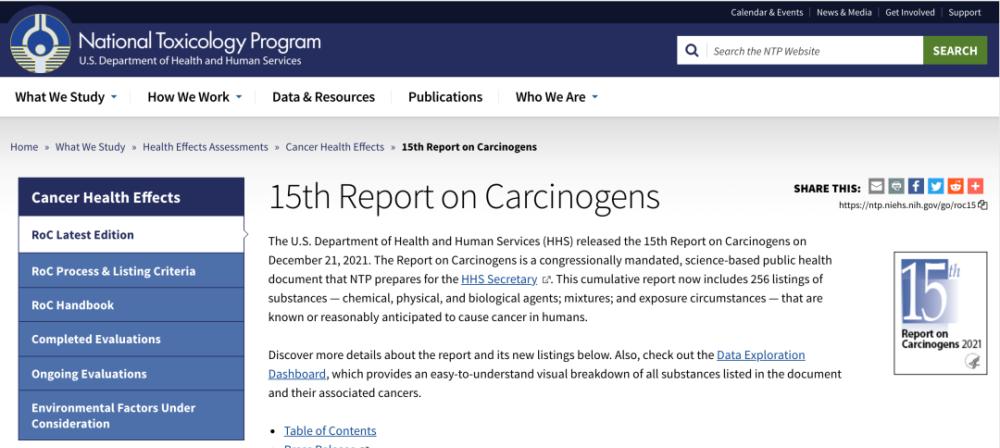The list of carcinogens has been updated!
After a lapse of five years, the U.S. Department of Health and Human Services updated the Carcinogen Report (15th Edition). The list of carcinogens adds eight to the list of 248 carcinogens in the 14th edition[1], including chemicals, physical factors, biological infectious factors and environmental exposures.

What are the 8 carcinogens added in the new version?
1. Chronic infection of Helicobacter pylori
The study on the relationship between Helicobacter pylori and cancer has received a large number of researchers' attention in recent years, and a large amount of research evidence has been obtained.
As the mechanism by which Helicobacter pylori induces cancer becomes clearer, its chronic infection is listed as a definitive human carcinogen in the list of carcinogens.
2. Antimony trioxide is listed as a reasonably suspected carcinogen
This is an inorganic compound that is mainly used in white pigments, paints, enamels and plastics, and can also be widely used as a flame retardant in plastics, rubber, etc.
3. Six kinds of haloacetic acid by-products after tap water disinfection
There are six new haloacetic acids added in this report, bromochloroacetic acid (BCA), bromodichloroacetic acid (BDCA), chlorodibromoacetic acid (CDBA), dibromoacetic acid (DBA), dichloroacetic acid (DCA), tribromoacetic acid (TBA).
The above acetic acid by-products are commonly found in tap water production and have carcinogenic side effects. However, in recent years, tap water disinfection technology and filtration technology have continued to advance, and the acetic acid content in water has also been strictly controlled, so we don't have to worry too much.
Reacquaint yourself with Helicobacter pylori
Among the 8 new carcinogens, the one with the most attention is Helicobacter pylori. The infection rate of this pathogen in China is as high as more than 50%[2], which means that one in two people is infected.
Infected with Helicobacter pylori,
How far away is it from cancer?
Chronic infection with Helicobacter pylori has been shown to be significantly associated with the development of gastric cancer. This pathogen mainly breaks the homeostasis of the gastric microenvironment in the body, resulting in gastritis and stomach ulcers, thereby increasing the risk of gastric cancer.
Epidemiological data suggest that more than 90 percent of patients with gastric cancer have an age of onset greater than 45 years [3]. And stomach cancer usually occurs 20 to 30 years after exposure to carcinogens. In summary, the "power" of Helicobacter pylori is gradually accumulated. In addition, bad habits such as high-salt pickled foods and smoking will further aggravate the damage of Helicobacter pylori to the gastric mucosa.
In addition to stomach cancer, the rate of Infection with Helicobacter pylori in patients with colon polyps is significantly higher than in normal populations [4], and infection promotes the progression of intestinal polyps, thereby increasing the risk of colorectal cancer.
What behaviors are possible
Will it infect us with Helicobacter pylori?
1. Oral transmission - eating together, etc
Intra-family transmission is an important route of Helicobacter pylori infection. Family meals and cups provide favorable conditions for Helicobacter pylori transmission. Many people are already infected with Helicobacter pylori in childhood, mainly from family members.
In addition, eating undercooked foods, eating out, kissing, etc. all increase the chance of infection with Helicobacter pylori.
2, fecal-oral transmission - do not pay attention to hand hygiene
Helicobacter pylori, which survives in the stool, contaminates water or food, and consuming these foods increases the chances of Helicobacter pylori infection.
3. Appetite spread
It refers to the transmission of Helicobacter pylori to healthy people through vomit from infected people, etc., and is commonly transmitted in children.
Must Helicobacter pylori be eradicated?
The Fifth National Consensus Report on the Treatment of Helicobacter pylori Infection gives guidance and recommendations for the eradication of Helicobacter pylori. Consensus emphasizes that gastritis of Helicobacter pylori infection is an infectious disease, and it is recommended that eradication of treatment targets can be extended to asymptomatic people.
However, China's large population base of infections, high rate of drug resistance and irregular treatment will lead to a decline in eradication rates, while the high rate of re-infection increases the cost of repeated treatment. Therefore, the complete eradication of helicobacter pylori is quite difficult.
However, eradication of Helicobacter pylori is strongly recommended in the following populations:
Patients with defined peptic ulcer, gastric MALT lymphoma;
Patients with gastric cancer, gastritis, patients after gastrectomy, patients who have been taking nonsteroidal anti-inflammatory drugs such as aspirin for a long time;
Diseases associated with Helicobacter pylori infection, such as anemia.
How can I prevent/eradicate Helicobacter pylori?
Some misunderstandings need to be cleared
Wrong practice
Eat health supplements to cure Helicobacter pylori
Inhibition of Helicobacter pylori by "probiotics"
Eradicated with "Anti-Helicobacter pylori" toothpaste
Eat super vegetables such as garlic and cabbage to kill bacteria
The right thing to do
Radical cure can only be achieved by drugs (including two antibiotics, a gastric mucosal protective drug, and a gastric acid suppressant drug).
Pay attention to review after treatment.
prophylaxis. Develop good hygiene habits: divide meals, use chopsticks, wash your hands before meals.
bibliography
[1]https://ntp.niehs.nih.gov/whatwestudy/assessments/cancer/roc/index.html
Liu Wenzhong, Xie Yong, Lu Hong, Cheng Hong, Zeng Zhirong, Zhou Liya, Chen Ye, Wang Jiangbin, Du Yiqi, Lü Nonghua. The Fifth National Consensus Report on the Treatment of Helicobacter pylori Infection[J].Chinese Journal of Practical Internal Medicine,2017,37(06):509-524.
[3] Machlowska J, et al. Gastric Cancer: Epidemiology, Risk Factors, Classification, Genomic Characteristics and Treatment Strategies. Int J Mol Sci. 2020 Jun 4;21(11):4012.
Guo Zewei,Shao Lichun. Correlation analysis between Helicobacter pylori infection and colon polyps[J].Journal of Clinical Military Medicine,2020,48(08):913-914.